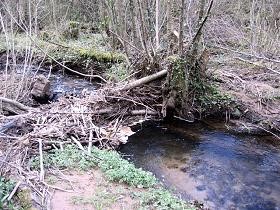Government praises “truly innovative” Natural Flood Protection Scheme
A report from the Environment Agency has conclusively demonstrated the real community benefits of letting nature do much of the work with flood defence protection.
The natural flood management scheme near to Pickering, North Yorkshire proved its mettle during the intense Christmas storms that affected many other towns and villages across the county.
The pioneering scheme which used a series of bunds slowed river peak flow by 15-20%, saving Pickering’s museum and several homes, Environment Agency (EA) analysis revealed.
Pickering has a long history of flooding and whilst a flood alleviation scheme has been proposed in recent years, it is of too low a priority in terms of cost-benefit to be considered for approval. The town is particularly at risk from summer flash floods due to the steep nature of the catchment. It has suffered from four serious floods in the past 10 years.
Slowing the Flow at Pickering is a partnership project. It is led by Forest Research, closely supported by Forestry Commission England, The Environment Agency, The North York Moors National Park Authority, Durham University, Natural England and the wider community. The lead funder is Defra.
The new approach to flood management relies on making changes to the way the landscape is managed, so that the passage of rainfall to rivers and its movement downstream is reduced and delayed. This involves a range of ‘measures’, including:
- Constructing low-level bunds;
- Planting more trees, especially along stream sides and in the floodplain;
- Restoring woody debris dams in small streams;
- Restoring wetlands.
The above to the left shows some placed natural debris in the pathway of the catchment. Large woody debris dams help to increase flood storage by creating an upstream pool and reconnecting streams with their floodplain. Long, low, leaky dams were installed to slow the flow of water off the slopes.
Along with 40,000 extra trees and heather moorland planted upstream, the scheme managed to absorb more than 2ins (5cm) of rain, which fell in the area over 36 hours from 26 December.
The natural scheme was favoured as the alternative was excessively high flood defence walls which would be unsightly and disruptive to the community.
While the EA warned the scheme the scheme would not work in extreme rainfall, it has been praised by Environment Secretary Elizabeth Truss as “truly innovative”.
In a statement, Truss went on to say that natural flood defence measures “can also deliver more benefits than just reducing flood risk such as improving water quality, preventing erosion and in some cases storing carbon.”
“Natural and man-made defences both have a role to play in reducing flooding, but every approach must be tailored to local geography and knowledge,” she said.
Ms Truss is setting out a 25-year plan for the environment, looking at the management of river catchment areas as a whole, to improve flood resilience.
A recent report suggested re-foresting up to 40% of river catchments could help prevent floods.
Stepping up to the natural flood management challenge
Pickering demonstrates how with better data and understanding of river flow, groundwater modelling and runoff within sensitive catchments, the right natural schemes can be implemented with massive community benefits.
GeoSmart is working closely with the Regulator, councils and water companies to model solutions that can be implemented nationwide.
Our recent success at the Geovation Water Challenge for sustainable river catchments will act as a template for how meaningful information can be developed commercially for stakeholders based on local conditions – thereby satisfying the Environment Secretary and Regulator’s key objective.
For more information on our approach, get in touch today.




